The fifth chapter of Mishnah Avot (a/k/a Pirqei Avot) enumerates ten or more mythopoetic anomalies, all of which were created “on the eve of the Sabbath at twilight” — underscoring that the Creator was productive until the very first moment of the Shabbat, and that unlike for us, the hazy, liminal period between day and night is clearly defined for the Creator of Time. This litany of anomalies includes ten of biblical and parabiblical lore including “the Rainbow.” At first read, one might imagine this rainbow refers to the sign of the Noaḥide covenant (Genesis 9:12-17). But as with the way of reading Torah in the Jewish tradition, every verse is pregnant with meaning and intertextual references, and so one may be surprised to learn the anomalous Rainbow is not (or not only) that of Genesis after the Flood, but rather one identified with another miracle altogether — that of the Division of the Sea of Reeds. Such a reading is provided in Maimonides’ commentary on Pirqei Avot 5:4 where he provides the “received tradition” (qabalah) of the ten miracles at the Yam Suf according to midrash. In the parabiblical legend, the Sea of Reeds was split not into two but rather twelve distinct parts, one for each shevet, peripatetic tribe of the Israelites. The Rainbow, normally, seven colors, is here re-imagined analogous to these twelve submarine channels as possessing twelve distinct hues. Overall, the narrative parallel between the story of the Exile from Eden and the Survival of the Deluge is more strongly bridged with the Exodus from Egypt’s Goshen and the Passage through the Sea of Reeds.
| Source (Hebrew) | Translation (English) |
|---|---|
The ten tests with which Avraham, our father, was tested are all [in] the words of Scripture. But the ten miracles[1] In Hebrew, nissim (lit. “banners”). Miracles are as banners signifying divine intervention. that were at the Sea is a received tradition. | |
הראשון הבקעת המים כפשוטו של פסוק ויבקעו המים (שמות יד:כא). |
The first is the splitting of the water like the simple understanding of the verse, “and the water split” (Exodus 14:21). |
ה-ב’ שאחר שבקעו נעשה כקובה עד ששב כדמות גג ולא מקורה ולא משופע והיה הדרך כאילו היה נקב במים והמים מימין ומשמאל וממעל הוא מאמר חבקוק נקבת במטיו ראש פרזיו (חבקוק ג:יד). |
The second is that after the sea split, it became like a tent until it turned into a kind of roof – not of beams and not slanted – [rather] the path was as if there was a cavern in the water and the water was on the right and on the left and on top. It is [like] the statement of Ḥabaquq, “You have pierced with his rods, the head of his rulers” (Habakuk 3:14). |
ה-ג’ שארצו נתקשה ונקפל להם כאמרו הלכו ביבשה (שמות יד:כט) ולא נשאר בקרקעיתו שום חומר וטיט כבשאר נהרות. |
The third is that its ground became hard and solid, as it states, “they walked on dry land” (Exodus 14:29) and there did not remain any [wet] clay and mud as in other rivers. |
ה-ד’ שדרכי מצריים היו בחומר מדובק והוא אמרו חומר מים רבים (חבקוק ג:יד). |
The fourth is that the paths of the Egyptians were in quicksand, and that is its stating, “the clay of great waters” (Habakuk 3:14). |
וה-ה’ שנבקעו לדרכים רבים כמספר השבטים כעין קשת עגול על זאת הצורה והוא אמרו לְגֹזֵ֣ר יַם־ס֭וּף לִגְזָרִ֑ים (תהלים קלו:יג). |
The fifth [miracle at the Sea of Reeds] is that it was divided into many paths equal to the number of tribes as the appearance of a rounded bow, as per this drawing.[2] Find attached illustration. And so it is stated, “who divided (l’gozer) the Sea of Reeds into parts (gezarim)” (Psalms 136:13).[3] The midrash here is coming to provide an explanation for the repetition of גזר — why if the Sea was “split,” must the verse Psalms 136:13 add “into parts”? The use of repetitive language is a common inspiration for midrashic readings, otherwise explained by simple poetic license. The use of the Rainbow as an analagous comparative for this already surprising reading, is unexplained by the midrash, but find my reasoning above in the introduction. |
וה-ו’ שנקפאו המים ונתקשו כאבנים ועל זה אמר שברת ראשי תנינים על המים (תהלים עד:יג) ר”ל שנתקשו המים עד ששבו בענין שישבור הראשים עליהם. |
The sixth is that the water congealed and became as hard as boulders. And about this, it stated, “you broke the head of the taninim[4] often translated as ‘sea monsters' upon the waters” (Psalms 74:13) meaning to say that the waters hardened to the point that they went back in such a way that heads would break on them. |
וה-ז’ שלא נקפאו כקפיאת שאר המים הנקפאים ר”ל חתיכה אחת אבל היו חתיכות רבות כאילו הם אבנים וסדרו קצתם על קצתם והוא אמרו אתה פוררת בעזך ים (תהלים עד:יג) |
And the seventh is that it did not congeal like the solidifying of other waters that congeal – meaning to say [into] one piece, but rather [into] many pieces, as if they were [building] stones and they were arranged some on top of others. And that is its stating, “You crumbled the sea with your power” (Psalms 74:13). |
וה-ח’ שנקפה כזכוכית או כשהם ר”ל בהיר עד שיראו קצתם אל קצתם בעברם בו והוא אמרו חשכת מים עבי שחקים (תהלים יח:יב) ר”ל שקבוץ המים היה כעצם השמים לטוהר (שמות כד:י) שהוא בהיר. |
The eighth is that it congealed like glass or onyx – meaning to say, it was clear to the point that some of [the tribes] would see each other while crossing [through] it. And this is in its stating, “the darkness of the waters, the clouds of the sky,” (Psalms 18:12) which is to say that the gathering of waters was ‘like the essence of the sky in purity’ (Exodus 24:10) which is clear. |
וה-ט’ שהיו נוזלים ממנו מים מתוקים והיו שותים אותם. |
The ninth – that sweet water would flow from it and they would drink it. |
והיו”ד שהיו נקפים בעת שהיו נוזלים אחר שלקחו מהם מה ששתו עד שלא היו יורדין לארץ והוא אמרו נצבו כמו נד נוזלים (שמות טו:ח) ר”ל הדבר הנוזל היה נקפה בלב ים ומצאנו בקבלה ג”כ שהמצריים באו עליהם מכות על הים יותר ממכות מצרים אבל כלם היו מעשרה המינים ההם אשר ירדו במצרים ונחלקו למינים רבים על הים ואל זה רמז באמרו אלה הם האלהים המכים את מצרים בכל מכה במדבר (שמואל א׳ ד:ח) ר”ל במדבר ים סוף. |
The tenth is that it would congeal at the time that it flowed, after they took what they drank from it – to the point that it would not fall to the ground. And that is its stating, “they [the waters] stood up like a flowing stack” (Exodus 15:8) meaning to say the thing that was flowing congealed in the heart of the sea. And in the tradition we found that more plagues came upon the Mitsrim at the Sea than the plagues that came upon them in Mitsrayim. But all of them derived from those ten species that came down in Mitsrayim, and they divided into a multitude of plagues at the Sea. And the hint to this is in its stating, “They are the same Elohim who struck the Mitsrim with every plague in the wilderness” (I Samuel 4:8) meaning to say in the wilderness (midbar) of the Sea of Reeds. |
Illustration of the the miracle at the Sea of Reeds and twelve hued rainbow as found in the British Library manuscript, Add 14763; Miscellany of philosophical works including by Maimonides; 13th c.; Italy (Viterbo); f.135r.

BL Add 14763; Miscellany of philosophical works including by Maimonides; 13th c; Italy (Viterbo); f.135r
With gratitude to Ennius for posting an image of this folio. Thank you to Rabbi Oded Mazor for identifying the sourcetext of the Maimonidean commentary illustrated.
Notes
| 1 | In Hebrew, nissim (lit. “banners”). Miracles are as banners signifying divine intervention. |
|---|---|
| 2 | Find attached illustration. |
| 3 | The midrash here is coming to provide an explanation for the repetition of גזר — why if the Sea was “split,” must the verse Psalms 136:13 add “into parts”? The use of repetitive language is a common inspiration for midrashic readings, otherwise explained by simple poetic license. The use of the Rainbow as an analagous comparative for this already surprising reading, is unexplained by the midrash, but find my reasoning above in the introduction. |
| 4 | often translated as ‘sea monsters' |

“הנסים שהיו על הים סוף | The Miracles at the Sea of Reeds as related in Rambam’s commentary on the Pirqei Avot” is shared through the Open Siddur Project with a Creative Commons Attribution-ShareAlike 4.0 International copyleft license.
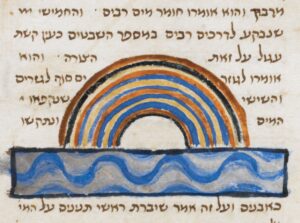
![[The Sea of Reeds Parting, Pharoah’s army drowned] from the Rhylands Haggadah.](https://opensiddur.org/wp-content/uploads/2013/03/sea-parting.jpg)

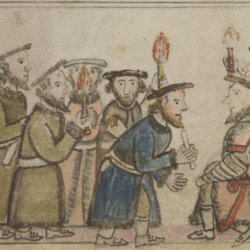

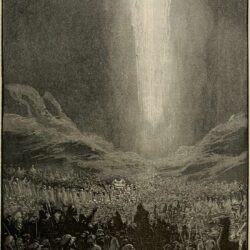
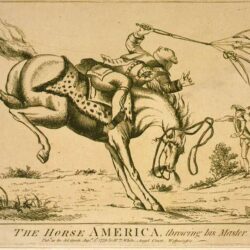
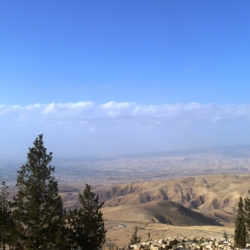


כולם דבר הכתוב….
אבל ה-יו״ד נסים שהיו על הים
הם קבלה.